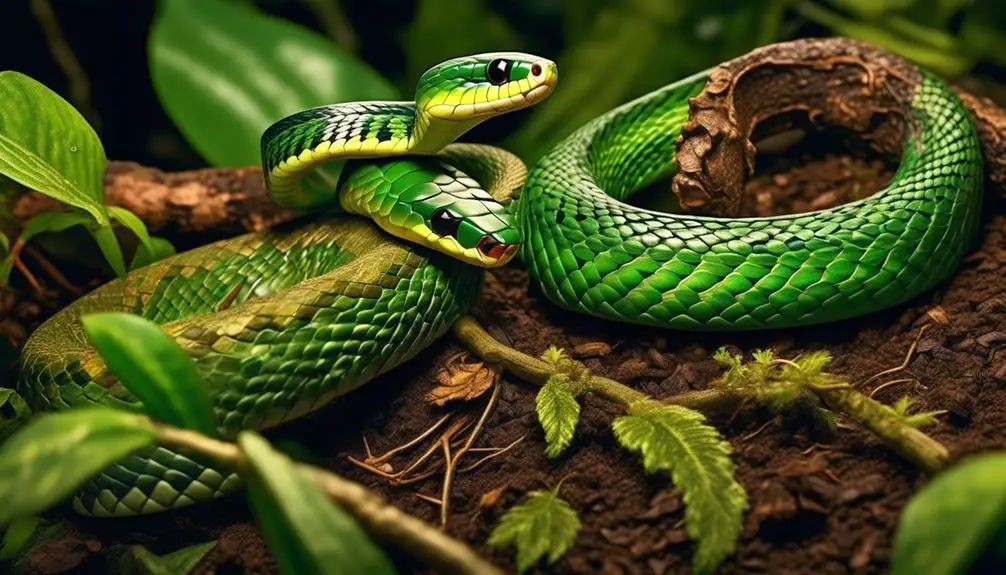Are you planning a trip to Hawaii and wondering if there are snakes slithering through the paradise-like landscapes? Well, the answer is not as straightforward as you might expect.
While Hawaii is known for its stunning biodiversity, it lacks one particular creature – native snakes. However, there have been instances of snakes being found on the islands, and it’s a topic of concern for authorities and conservationists.
In this article, we will explore the intriguing world of snakes in Hawaii, including how they got there, the dangers they pose, and the illegal status of keeping them as pets.
So, get ready to unravel the truth behind the presence of these elusive reptiles in the enchanting islands of Hawaii.
Snake Species in Hawaii

There are several snake species found in Hawaii, each with distinct characteristics and behaviors.
The Brahminy blind snake is a nonvenomous species that reproduces through parthenogenesis. Females of this species feed on ants and termites.
The Yellow-bellied sea snake, on the other hand, is venomous and rarely ventures onto dry land. Its bite can cause symptoms such as drowsiness, vomiting, muscle pain, and potential fatality.
The Brown tree snake, not native to Hawaii, is known to cause devastation to the local habitat. It climbs onto power lines, causing blackouts. Strict checks are in place to prevent the entry of this species into Hawaii.
The Boa constrictor, another nonvenomous snake, employs a deadly method of attacking prey through constriction. It feeds on small rodents and amphibians and is illegal to own as pets in Hawaii.
The Ball python, also nonvenomous, can grow up to six feet in length and has the potential to devastate Hawaii’s ecosystem if allowed to roam free.
The Southern black racer, occasionally entering Hawaii accidentally, is a nonvenomous snake known for its high speed and ability to feed on anything it can capture and kill.
Lastly, the Garter snake, accidentally brought to Hawaii through Christmas tree shipments, is harmless to humans and possesses weak venom in small quantities.
Characteristics and Behaviors of Snake Species

The snake species in Hawaii exhibit a range of characteristics and behaviors, each with unique adaptations and ways of interacting with their environment.
The Brahminy blind snake, a nonvenomous species, reproduces through parthenogenesis and feeds on ants and termites.
The yellow-bellied sea snake, on the other hand, is venomous and rarely ventures onto dry land. Its bite can cause symptoms such as drowsiness, vomiting, muscle pain, and potential fatality.
The brown tree snake, not native to Hawaii, causes devastation to the local habitat and is known for climbing onto power lines, causing blackouts.
The boa constrictor, another nonvenomous species, uses constriction as a deadly way of attacking prey and feeds on small rodents and amphibians. It’s illegal to own boa constrictors as pets in Hawaii.
The ball python, also nonvenomous, grows up to six feet in length and has the potential to devastate Hawaii’s ecosystem if allowed to roam free.
The southern black racer, occasionally accidentally entering Hawaii, is a constrictor like the boa constrictor, known for its high speed and the ability to feed on anything it can capture and kill.
Lastly, the garter snake, accidentally introduced to Hawaii through Christmas tree shipments, is harmless to humans, with weak venom in small quantities.
Snake Introductions to Hawaii

Snakes have been introduced to Hawaii through various means, posing a potential threat to the delicate ecosystem of the islands. These introductions can occur through cargo shipments, planes, boats, or even illegally through black market traders. Strict border patrols and conservation efforts are in place to prevent snake entry into Hawaii, but there is still a thin chance of encountering them. The punishments for importing snakes include fines up to $200,000 or three years in prison, emphasizing the seriousness of the issue.
| Snake Introductions to Hawaii | |
|---|---|
| 1 | Almost all larger mammals and insects in Hawaii introduced by humans |
| 2 | Snakes feared to have a devastating effect on the delicate ecosystem |
| 3 | Some snakes may have made it through the checks, posing a thin chance of encountering them |
Despite these efforts, the Yellow-bellied sea snake, a venomous species, has managed to reach Hawaii on its own and lives in the surrounding waters. This snake is the most dangerous in Hawaii, with venom capable of killing a person. On the other hand, the Brahminy blind snake, which is also found in Hawaii, poses no danger to humans.
It is important to note that there are no native snakes in Hawaii. The few snake species present in the islands have been accidentally or illegally introduced. Hawaii’s isolation prevented the natural presence of snakes, allowing the local fauna to evolve separately from creatures in other continents. Keeping snakes as pets in Hawaii is illegal due to the potential impact on the islands’ natural ecosystem. The prohibition aims to prevent disruptions to the food chain and uncontrolled population growth.
Preventing Snake Introductions in Hawaii
To prevent snake introductions in Hawaii, strict border patrol measures have been implemented. This includes closely monitoring cargo shipments, planes, and boats from other countries or islands where snakes are common. The goal is to detect and intercept any snakes being brought into the islands, whether it is accidental or intentional.
Punishments for illegal importation of snakes are severe to serve as a deterrent for potential black market traders. Offenders can face hefty fines and even imprisonment. These measures aim to effectively prevent the introduction of snakes into Hawaii and protect the unique ecosystem of the islands.
Border Patrol Measures
Border Patrol measures play a crucial role in safeguarding Hawaii’s delicate ecosystem by preventing the introduction of snakes to the islands. These measures are in place to ensure that snake species, such as the Brown tree snake and the Ball python, do not enter Hawaii and cause devastation to the local habitat. The table below provides an overview of the various Border Patrol measures:
| Border Patrol Measures | Purpose |
|---|---|
| Strict checks | Prevent entry of the Brown tree snake that climbs onto power lines and causes blackouts |
| Punishments | Fines up to $200,000 or three years in prison for importing snakes |
| Cargo inspections | Prevent accidental importation of snakes through cargo shipments, planes, or boats |
| Black market control | Combat illegal importation of snakes as pets |
These measures are necessary as snakes could disrupt the delicate food chain and cause uncontrolled population growth, leading to the potential devastation of Hawaii’s unique ecosystem. By enforcing these Border Patrol measures, Hawaii can continue to thrive as a snake-free environment.
Punishments for Illegal Importation
The penalties for illegally importing snakes into Hawaii are severe, with fines of up to $200,000 or a maximum prison sentence of three years. These punishments aim to deter individuals from introducing snakes into the delicate ecosystem of Hawaii.
The fear is that snakes, such as the brown tree snake or the ball python, could have a devastating effect on the local habitat and disrupt the food chain. Strict border patrols and conservation efforts are in place to prevent snake introductions, but there’s still a slight chance that some snakes may have made it through the checks.
It’s also possible that illegal traders are illegally importing snakes as pets. The goal is to maintain the absence of snakes in Hawaii, as they aren’t native to the islands and could have detrimental consequences for the unique fauna and ecosystem.
Possible Encounters With Snakes in Hawaii

When encountering a snake in Hawaii, it’s important to prioritize safety and take appropriate measures to avoid any potential harm. Remember to keep a safe distance from the snake and avoid provoking or approaching it.
If you happen to come across a snake, it’s crucial to report the sighting to the local authorities for proper identification and handling.
Snake Safety Tips
If you happen to encounter a snake in Hawaii, it’s important to be aware of snake safety tips to ensure your well-being and minimize any potential harm.
First and foremost, maintain a safe distance from the snake. Snakes can strike quickly and their bites can be dangerous, so it’s best to keep a distance of at least six feet.
Avoid provoking or antagonizing the snake, as this may cause it to become defensive and increase the likelihood of an attack.
Don’t attempt to handle or capture the snake, as this can be extremely dangerous without the proper knowledge and equipment.
It’s also important to stay calm and avoid sudden movements, as this may startle the snake and trigger an aggressive response.
Lastly, it’s recommended to contact local authorities or snake removal experts to safely handle the situation and ensure the snake is properly relocated or removed from the area.
Reporting Snake Sightings
After familiarizing yourself with snake safety tips in Hawaii, it is crucial to understand the importance of reporting any snake sightings or possible encounters to ensure the appropriate actions can be taken to address the situation effectively. Reporting snake sightings allows authorities to gather valuable data on the presence and distribution of snakes in Hawaii, aiding in the development of effective management strategies. To report a snake sighting, you can contact the Hawaii Department of Agriculture or the Hawaii Invasive Species Council. Provide them with detailed information such as the location, date, time, and description of the snake. The table below summarizes the contact information for reporting snake sightings in Hawaii.
| Organization | Contact Information |
|---|---|
| Hawaii Department of Agriculture | Phone: 808-832-0585 |
| Email: [email protected] | |
| Online Form: hdoa.hawaii.gov | |
| Hawaii Invasive Species Council | Phone: 808-587-0166 |
| Email: [email protected] | |
| Online Form: reportapest.org |
Punishments for Importing Snakes in Hawaii
Importing snakes into Hawaii is strictly prohibited, and those who violate this law face severe punishments. The state of Hawaii has implemented strict regulations and penalties to prevent the introduction of snakes into the delicate ecosystem of the islands. The penalties for importing snakes include fines of up to $200,000 or up to three years in prison.
These stringent measures are in place to protect the unique flora and fauna of Hawaii, which have evolved separately from creatures found on other continents due to the islands’ isolation. The absence of native snakes in Hawaii is a testament to the successful efforts to prevent their introduction. The few snake species found in Hawaii, such as the Brahminy blind snake and the yellow-bellied sea snake, have been accidentally introduced or have arrived on their own in the surrounding waters.
Illegal importation of snakes into Hawaii may occur through cargo shipments, planes, or boats from other countries or islands where snakes are more common. There’s also a concern about black market traders illegally importing snakes as pets. These activities pose a serious risk to the delicate ecosystem of the islands, as snakes can disrupt the food chain and cause uncontrolled population growth.
The strict punishments for importing snakes into Hawaii serve as a deterrent to potential violators. By enforcing these penalties, the state aims to preserve the unique biodiversity and ecological balance of the islands.
Dangerous Snakes in Hawaii
When it comes to dangerous snakes in Hawaii, one species stands out: the venomous yellow-bellied sea snake. Capable of killing a person, its bite can lead to symptoms such as drowsiness, vomiting, muscle pain, and potential fatality.
On the other hand, the Brahminy blind snake poses no danger to humans, making it a non-threatening presence in Hawaii.
Venomous Sea Snake
The presence of venomous sea snakes in Hawaii poses a significant threat to both the local ecosystem and human safety. One such venomous species found in Hawaii is the yellow-bellied sea snake. These snakes rarely venture onto dry land and typically reside in the surrounding waters. However, if encountered, their venom can be deadly to humans. Symptoms of a yellow-bellied sea snake bite may include drowsiness, vomiting, muscle pain, and, in severe cases, potential fatality.
It’s crucial to exercise caution when swimming or engaging in water activities in Hawaii to minimize the risk of encountering these venomous sea snakes. Strict border patrols and conservation efforts are in place to prevent the introduction of snakes into Hawaii, but there remains a slim possibility of encountering them due to accidental importation or illegal trade.
Non-Dangerous Blind Snake
The non-dangerous blind snake found in Hawaii is the Brahminy blind snake. This species, also known as the flowerpot snake, belongs to the family Typhlopidae.
The Brahminy blind snake is a small, nonvenomous snake that reaches a length of about 6 to 8 inches. It has a cylindrical body, covered in smooth, shiny scales, and is usually dark brown or black in color.
This blind snake is unique in that it reproduces through parthenogenesis, meaning females can produce offspring without the need for fertilization by a male.
The Brahminy blind snake is an insectivore, primarily feeding on ants and termites. It’s a burrowing species, often found in gardens, plant pots, and other moist areas.
While harmless to humans, the presence of the Brahminy blind snake in Hawaii highlights the ongoing concerns about the introduction and potential impact of non-native snake species on the delicate ecosystems of the islands.
Illegal Pet Ownership
Illegal pet ownership of dangerous snakes in Hawaii poses a significant threat to the delicate ecosystems of the islands. The introduction of non-native snake species can disrupt the natural food chain and cause uncontrolled population growth, leading to devastating effects on the local fauna.
Snakes such as the boa constrictor and ball python, which are illegal to own as pets in Hawaii, have the potential to devastate the ecosystem if allowed to roam free. These snakes are nonvenomous but use constriction to attack their prey, which includes small rodents and amphibians.
Strict border patrols and conservation efforts are in place to prevent snake introduction, but there’s still a thin chance of encountering illegally imported snakes. It’s essential to understand the risks associated with illegal pet ownership and the potential harm it can cause to Hawaii’s delicate ecosystems.
Native Snakes in Hawaii

Occasionally, snakes that aren’t native to Hawaii may accidentally find their way to the islands. However, it’s important to note that there are no native snakes in Hawaii. The presence of snakes in Hawaii is largely due to human introduction or accidental importation.
One snake species that has been accidentally introduced to Hawaii is the Brahminy blind snake. This nonvenomous species is female and reproduces through parthenogenesis. It primarily feeds on ants and termites, posing no danger to humans.
Another snake species that occasionally enters Hawaiian waters is the yellow-bellied sea snake. This venomous species rarely ventures onto dry land and is known to have symptoms of drowsiness, vomiting, muscle pain, and potentially fatal bites. It’s important to exercise caution when encountering this snake.
Other snake species found in Hawaii, such as the brown tree snake, boa constrictor, ball python, southern black racer, and garter snake, aren’t native and have been either accidentally or illegally imported. These nonnative snakes have the potential to disrupt the delicate ecosystem of the islands.
To prevent the introduction of snakes, strict border patrols and conservation efforts are in place. Punishments for importing snakes include fines up to $200,000 or three years in prison. It’s crucial to respect and protect Hawaii’s unique biodiversity by adhering to the prohibition of keeping snakes as pets.
Absence of Snakes in Hawaii

Snakes aren’t native to Hawaii, and their absence on the islands is a result of the unique geographical isolation and evolution of the local fauna. Due to its remote location in the Pacific Ocean, Hawaii has been geographically isolated for millions of years. This isolation has prevented the natural presence of snakes on the islands. Snakes in Hawaii have been introduced by humans over the centuries, either accidentally or illegally. However, the absence of native snakes in Hawaii is significant.
The local fauna in Hawaii evolved separately from creatures in other continents, which means that snakes didn’t have the opportunity to colonize the islands naturally. This isolation has allowed for the development of a distinct and diverse ecosystem, which is one of the reasons why Hawaii is renowned for its unique flora and fauna.
Furthermore, the absence of snakes in Hawaii is also due to strict border patrols and conservation efforts. The introduction of snakes to the islands is strictly regulated, and there are severe punishments for importing them. These measures are in place to protect the delicate ecosystem of Hawaii, as snakes could disrupt the food chain and cause uncontrolled population growth.
Illegal Status of Snakes in Hawaii

The regulations surrounding the presence of snakes in Hawaii reflect the island’s commitment to preserving its delicate ecosystem and preventing any potential disruption to the local food chain and population growth. Keeping snakes as pets in Hawaii is illegal due to the potential impact on the natural ecosystem of the islands. The introduction of snakes could disrupt the food chain and cause uncontrolled population growth, leading to a decline in native species and potential ecological imbalance. The prohibition on snakes as pets is a measure to protect the unique biodiversity of Hawaii and maintain the delicate balance that has evolved over time.
The illegal status of snakes in Hawaii is enforced through strict border patrols and conservation efforts. There are severe punishments for importing snakes, including fines up to $200,000 or three years in prison. These measures are in place to deter individuals from attempting to bring snakes into the islands, whether accidentally or intentionally. The fear is that snakes, if introduced, could have a devastating effect on the delicate ecosystem of Hawaii, which has evolved separately from creatures in other continents due to its geographical isolation.
While the absence of native snakes in Hawaii is a natural occurrence, there’s a small chance that some snakes may have made it through the checks and are present on the islands. This possibility, although slim, means that encountering a snake in Hawaii isn’t entirely out of the question. However, the overall goal remains to prevent any further introduction of snakes and protect the unique biodiversity that makes Hawaii so special.

Erzsebet Frey (Eli Frey) is an ecologist and online entrepreneur with a Master of Science in Ecology from the University of Belgrade. Originally from Serbia, she has lived in Sri Lanka since 2017. Eli has worked internationally in countries like Oman, Brazil, Germany, and Sri Lanka. In 2018, she expanded into SEO and blogging, completing courses from UC Davis and Edinburgh. Eli has founded multiple websites focused on biology, ecology, environmental science, sustainable and simple living, and outdoor activities. She enjoys creating nature and simple living videos on YouTube and participates in speleology, diving, and hiking.

